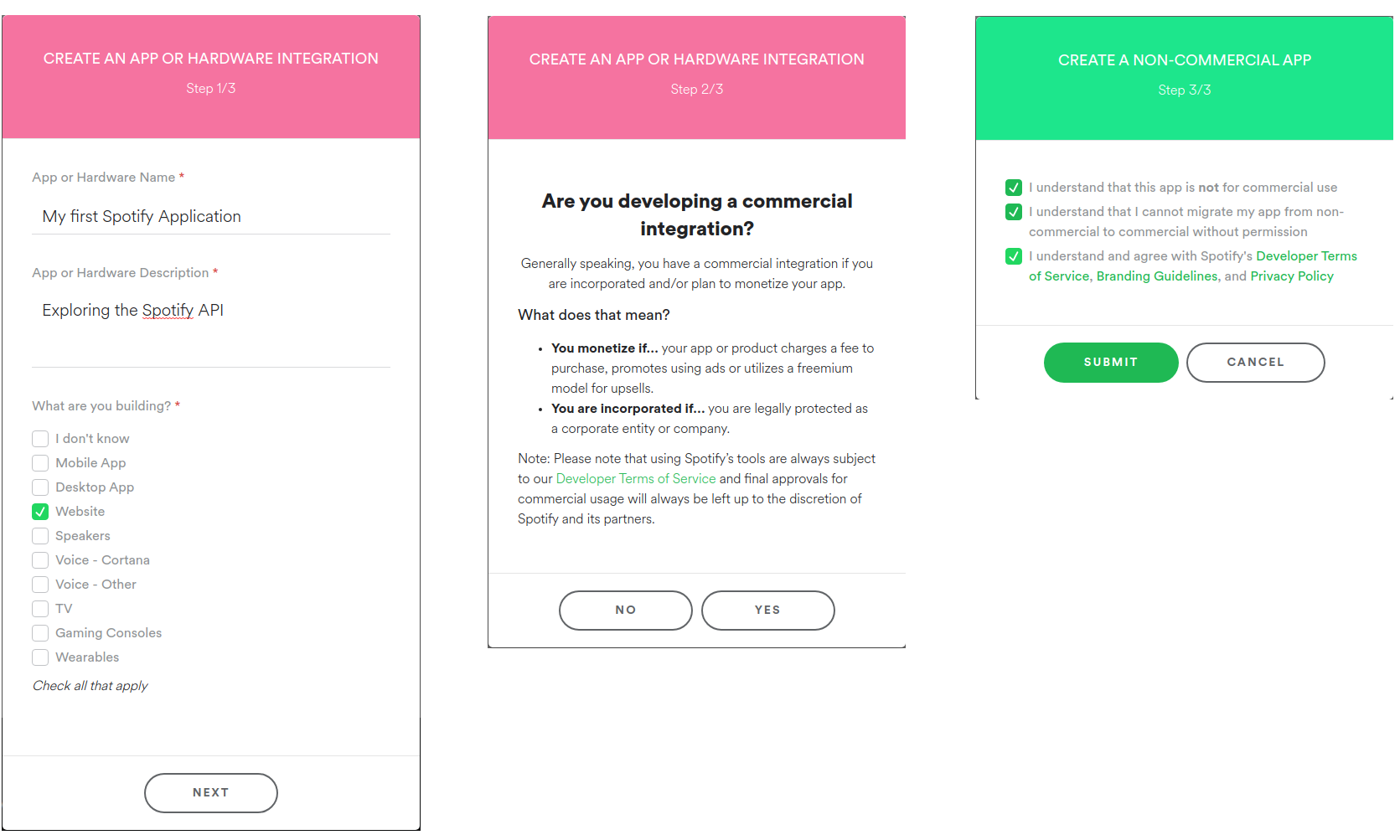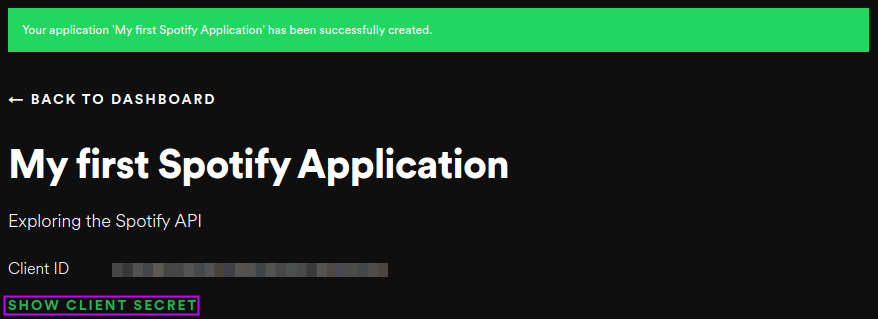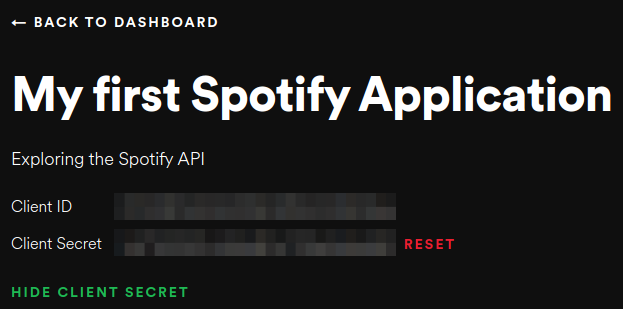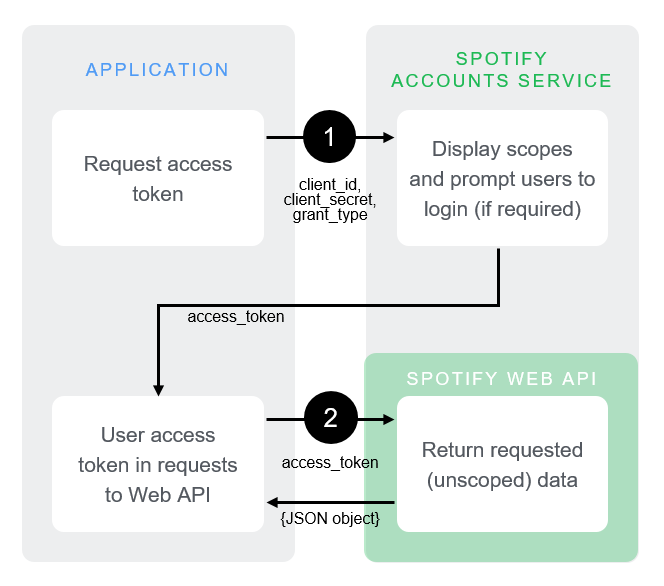Spotify API: Making my first call
I wanted to enrich the data for a little music application I’m working on and realised it would be a perfect opportunity to try out the Spotify API. I want to extract data about individual tracks (via the Tracks API), but before we do that we’ll need to create an app and have it approved for access to the Spotify API.

Registering an application
After logging into the Spotify Dashboard using my usual Spotify credentials, I was prompted to create an application:

We then have to fill in a three part form, providing some information about the application that we want to build:

Once we submit that form, we will be redirected to a screen similar to the following:

Before we start using the API in the next section, we’ll need to have our Client ID and Client Secret handy. The Client ID is already visible, and we can retrieve our Client Secret by clicking on the Show Client Secret link:

Once we click on that link, we’ll see the following screen:

We’re now ready to start using the API.
Requesting access token
Since we’re not interested in accessing user information via the API, we can use the Client Credentials Flow described in the Authorization Developer Guide. The diagram below, taken from this guide, explains how this works:

We’re going to use the Python requests library to call the /api/token endpoint.
This endpoint expects to receive the Authorization header parameter with a value set to a Base 64 encoded string of our Client ID and Client Secret, which we saw on our Dashboard in the previous section.
Let’s create environment variables containing these values, by running the commands below on our terminal window:
| == Don’t forget to change the placeholder values to your Client ID and Client Secret. == |
export CLIENT_ID="<our-client-id>"
export CLIENT_SECRET="<our-client-secret>"Once we’ve done that, we can write the following Python script to get an access token:
spotify_exploration.py
import requests
import base64
import os
import json
credentials = f"{os.environ['CLIENT_ID']}:{os.environ['CLIENT_SECRET']}"
encoded_credentials = str(base64.b64encode(credentials.encode("utf-8")), "utf-8")
payload = {"grant_type": "client_credentials"}
headers = {"Authorization": f"Basic {encoded_credentials}"}
response = requests.post("https://accounts.spotify.com/api/token",
headers=headers, data=payload).json()
print("Response:", response)If we run that script, we’ll see the following output:
Response: {'access_token': '<our-access-token>', 'token_type': 'Bearer', 'expires_in': 3600, 'scope': ''} |
Calling the Tracks API
We can now extend our script to make a call to the Tracks API to retrieve information about the UK’s longest running number 1 song of 2019, Dance Monkey:
token = response["access_token"]
headers = {"Authorization": f"Bearer {token}"}
track_response = requests.get("https://api.spotify.com/v1/tracks/2XU0oxnq2qxCpomAAuJY8K",
headers=headers).json()
print("Track Response:", json.dumps(track_response))If we run our script again, we’ll see the following output:
Track Response: {"album": {"album_type": "single", "artists": [{"external_urls": {"spotify": "https://open.spotify.com/artist/2NjfBq1NflQcKSeiDooVjY"}, "href": "https://api.spotify.com/v1/artists/2NjfBq1NflQcKSeiDooVjY", "id": "2NjfBq1NflQcKSeiDooVjY", "name": "Tones and I", "type": "artist", "uri": "spotify:artist:2NjfBq1NflQcKSeiDooVjY"}], "available_markets": ["AD", "AE", "AR", "AT", "BE", "BG", "BH", "BO", "BR", "CA", "CH", "CL", "CO", "CR", "CY", "CZ", "DE", "DK", "DO", "DZ", "EC", "EE", "EG", "ES", "FI", "FR", "GB", "GR", "GT", "HK", "HN", "HU", "ID", "IE", "IL", "IS", "IT", "JO", "JP", "KW", "LB", "LI", "LT", "LU", "LV", "MA", "MC", "MT", "MX", "MY", "NI", "NL", "NO", "OM", "PA", "PE", "PH", "PL", "PS", "PT", "PY", "QA", "RO", "SA", "SE", "SG", "SK", "SV", "TH", "TN", "TR", "TW", "US", "UY", "VN", "ZA"], "external_urls": {"spotify": "https://open.spotify.com/album/0UywfDKYlyiu1b38DRrzYD"}, "href": "https://api.spotify.com/v1/albums/0UywfDKYlyiu1b38DRrzYD", "id": "0UywfDKYlyiu1b38DRrzYD", "images": [{"height": 640, "url": "https://i.scdn.co/image/b98ddadfe65507738699fa7f80dc654f7f4d022d", "width": 640}, {"height": 300, "url": "https://i.scdn.co/image/2610e3524ce08c4d6ad16e7b9327f46998e1b821", "width": 300}, {"height": 64, "url": "https://i.scdn.co/image/93740961697e111d69fbbb8a16af64b354528cce", "width": 64}], "name": "Dance Monkey (Stripped Back) / Dance Monkey", "release_date": "2019-10-17", "release_date_precision": "day", "total_tracks": 2, "type": "album", "uri": "spotify:album:0UywfDKYlyiu1b38DRrzYD"}, "artists": [{"external_urls": {"spotify": "https://open.spotify.com/artist/2NjfBq1NflQcKSeiDooVjY"}, "href": "https://api.spotify.com/v1/artists/2NjfBq1NflQcKSeiDooVjY", "id": "2NjfBq1NflQcKSeiDooVjY", "name": "Tones and I", "type": "artist", "uri": "spotify:artist:2NjfBq1NflQcKSeiDooVjY"}], "available_markets": ["AD", "AE", "AR", "AT", "BE", "BG", "BH", "BO", "BR", "CA", "CH", "CL", "CO", "CR", "CY", "CZ", "DE", "DK", "DO", "DZ", "EC", "EE", "EG", "ES", "FI", "FR", "GB", "GR", "GT", "HK", "HN", "HU", "ID", "IE", "IL", "IS", "IT", "JO", "JP", "KW", "LB", "LI", "LT", "LU", "LV", "MA", "MC", "MT", "MX", "MY", "NI", "NL", "NO", "OM", "PA", "PE", "PH", "PL", "PS", "PT", "PY", "QA", "RO", "SA", "SE", "SG", "SK", "SV", "TH", "TN", "TR", "TW", "US", "UY", "VN", "ZA"], "disc_number": 1, "duration_ms": 209438, "explicit": false, "external_ids": {"isrc": "QZES71982312"}, "external_urls": {"spotify": "https://open.spotify.com/track/2XU0oxnq2qxCpomAAuJY8K"}, "href": "https://api.spotify.com/v1/tracks/2XU0oxnq2qxCpomAAuJY8K", "id": "2XU0oxnq2qxCpomAAuJY8K", "is_local": false, "name": "Dance Monkey", "popularity": 100, "preview_url": "https://p.scdn.co/mp3-preview/535ffea66207a0fc07d57fbaea7b5594be797f9b?cid=<our-client-id>", "track_number": 2, "type": "track", "uri": "spotify:track:2XU0oxnq2qxCpomAAuJY8K"} |
We’ve now successfully made our first call to the Spotify API. And it’s onwards with the rest of our application!
About the author
I'm currently working on short form content at ClickHouse. I publish short 5 minute videos showing how to solve data problems on YouTube @LearnDataWithMark. I previously worked on graph analytics at Neo4j, where I also co-authored the O'Reilly Graph Algorithms Book with Amy Hodler.
